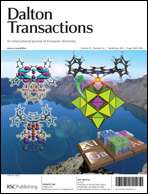Dalton Transactions
Dalton Transactions is a peer-reviewed scientific journal publishing original (primary) research and review articles on all aspects of the chemistry of inorganic, bioinorganic, and organometallic compounds. It is published weekly by the Royal Society of Chemistry. The journal was named after the English chemist, John Dalton, best known for his work on modern atomic theory. Authors can elect to have accepted articles published as open access.[1] The editor is Andrew Shore.[2] Dalton Transactions was named a "rising star" by In-cites from Thomson Scientific in 2006.[3]
 | |
| Discipline | Chemistry |
|---|---|
| Language | English |
| Edited by | Andrew Shore |
| Publication details | |
| History | Journal of the Chemical Society A: Inorganic, Physical, Theoretical (1966–1971) Journal of the Chemical Society, Dalton Transactions: Inorganic Chemistry (1972–2003) Dalton Transactions (2003–present) |
| Publisher | Royal Society of Chemistry (United Kingdom) |
| Frequency | Weekly |
| Hybrid | |
| 4.052 (2018) | |
| Standard abbreviations | |
| ISO 4 | Dalton Trans. |
| Indexing | |
| CODEN | DTARAF |
| ISSN | 1477-9226 (print) 1477-9234 (web) |
| LCCN | 2003242012 |
| OCLC no. | 51500500 |
| Links | |
Publication history
The journal was established as the Journal of the Chemical Society A: Inorganic, Physical, Theoretical in 1966. In 1972, the journal was divided into three separate journals: Journal of the Chemical Society, Dalton Transactions (covering inorganic and organometallic chemistry), Journal of the Chemical Society, Faraday Transactions 1: Physical Chemistry in Condensed Phases, and Journal of the Chemical Society, Faraday Transactions 2: Molecular and Chemical Physics. The Journal of the Chemical Society, Dalton Transactions was renamed in 2003 to Dalton Transactions. In January 2000, Acta Chemica Scandinavica was absorbed.[4]
While the Journal of the Chemical Society, Dalton Transactions was published as 12 issues a year from 1972, as submissions increased, the journal switched to 24 issues a year in 1992[5] and then to 48 issues a year in 2006.[6]
In 2010, the journal introduced a sequential volume numbering scheme, with one volume per year. While volume numbers were not assigned retro-actively, the first issue of 2010 was assigned volume 39 (2010 being the 39th year since the establishment of the Journal of the Chemical Society, Dalton Transactions.[7]
Subject coverage
Dalton Transactions publishes articles on all aspects of the chemistry of inorganic and organometallic compounds, including bioinorganic, biological inorganic, and solid-state inorganic chemistry; the application of physicochemical techniques to the study of their structures, properties, and reactions, including kinetics and mechanisms; synthesis and characterisation of new inorganic materials; homogeneous and heterogeneous catalysis; new or improved experimental techniques and syntheses.
Abstracting and indexing
The journal is abstracted and indexed in:[8]
According to the Journal Citation Reports, the journal has a 2018 impact factor of 4.052, ranking it 5th out of 44 journals in the category "Chemistry, Inorganic & Nuclear".[9]
Notable articles
According to the Web of Science, the following three articles have been cited most often:[10]
- C Janiak (2000). "A critical account on π–π stacking in metal complexes with aromatic nitrogen-containing ligands". Dalton Trans. (21): 3885–3896. doi:10.1039/B003010O.
- C Janiak (2003). "Engineering coordination polymers towards applications". Dalton Trans. (14): 2781–2894. doi:10.1039/B305705B. S2CID 96914248.
- M Bochmann (1996). "Cationic Group 4 metallocene complexes and their role in polymerisation catalysis: the chemistry of well defined Ziegler catalysts". J. Chem. Soc., Dalton Trans. (3): 255–270. doi:10.1039/DT9960000255.
Dalton Discussions
Dalton Discussions are scientific meetings that provide a forum for the exchange of views and newly acquired results in focused areas of inorganic chemistry. The papers, which are associated with the oral presentations at the meeting, are published in a special issue of Dalton Transactions, which constitutes a permanent record of the meeting. The meetings are usually held annually.[11]
See also
- List of scientific journals in chemistry
- Important publications in inorganic chemistry
References
- "RSC Open Access". Rsc.org. Retrieved 15 March 2013.
- "Editorial Board". Royal Society of Chemistry. Retrieved 20 January 2015.
- "Rising Stars - May 2006". in-cites. 18 October 2004. Archived from the original on 21 July 2013. Retrieved 15 March 2013.
- Harnung, S (2001). "Acta Chemica Scandinavica". Dansk Kemi. 82: 44–46.
- Dean, J (1992). "Editorial". J. Chem. Soc., Dalton Trans. Royal Society of Chemistry: vii–viii. doi:10.1039/DT99200F0VII.
- Humphrey, J; Walton, P (2006). "Dalton Transactions: Developing for the Inorganic Community". Dalton Trans. Royal Society of Chemistry (1): 15–17. doi:10.1039/B516708F. Retrieved 26 February 2011.
- "RSC - ChemComm & Dalton Transactions". Royal Society of Chemistry.
- "Dalton Transactions". Master Journal List. Thomson Reuters. Retrieved 29 January 2011.
- "Journals Ranked by Impact: Chemistry, Inorganic & Nuclear". 2014 Journal Citation Reports. Web of Science (Science ed.). Thomson Reuters. 2016.
- "Web of Science". 2010. Retrieved 31 January 2011.
- "Past Dalton Discussions". Dalton Transactions. Retrieved 15 March 2013.